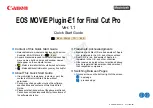
UAD Powered Plug-Ins Manual
- 327 -
Chapter 30: Manley Massive Passive EQ
The Channel Gain controls are intended to help match levels between “By-
pass” and “EQ enabled” modes so that the EQ effect can be more accurately
judged. With drastic EQ there may not be enough range to match levels, but
with drastic EQ this kind of comparison is of little use. The range is small to al-
low easier and finer adjustments.
Filters
Low Pass and High Pass filters are available for both channels. The response
curves of the filters are shown in
Figure 109
below. The available Filter values
differ between the standard and mastering versions; see
Table 24 on
page 322
for the available values for each version.
Low Pass
The Low Pass filter allows the channel’s lower frequencies to
pass while attenuating higher frequencies. The slope of the
Low Pass filter depends on the value set for the filter. At 6K,
7K5, and 9K values, the filter slope is 18 dB/octave. At these
values, a small (1.5 to 2 dB) bump occurs in the response before the curve
drops off. At 12K, the slope is 30 dB/octave. At 18K, a modified elliptical fil-
ter is used.
In the mastering version, when Low Pass is set to 27kHz the frequency re-
sponse is down by about 0.6 dB at 20kHz. When the control is set to 52kHz,
there is actually a boost of about 0.4 dB at 20kHz; the filter is slightly reso-
nant at this setting so there is a slight boost before the filter starts rolling off.
High Pass
The High Pass filter allows the channel’s higher frequencies to
pass while attenuating lower frequencies. The slope of the
High Pass filter is 18 dB/octave.
















































